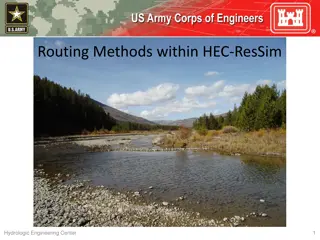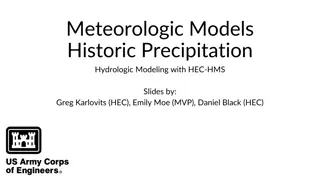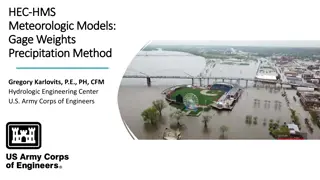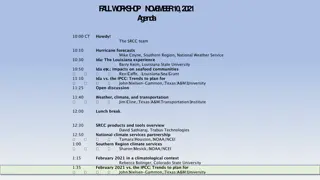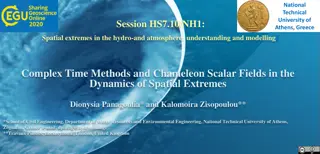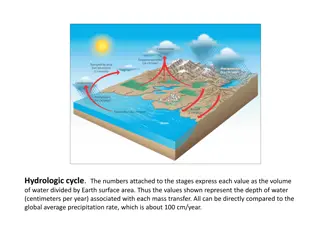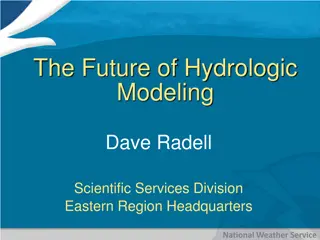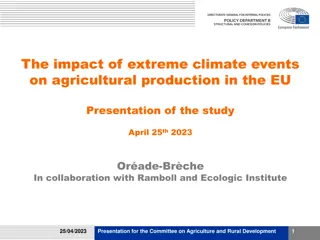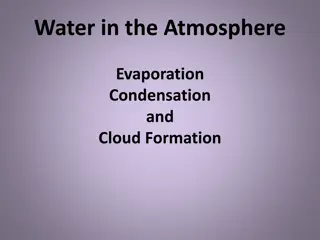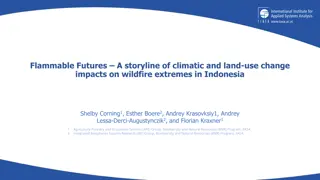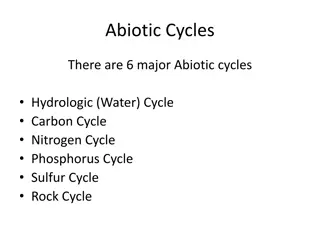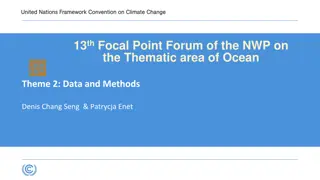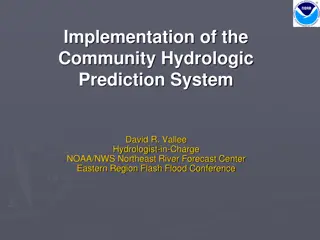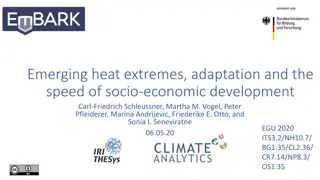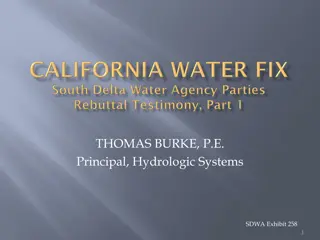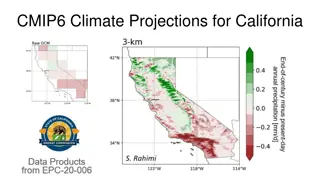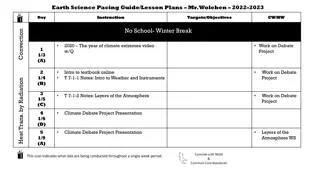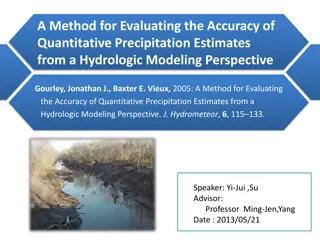Hydrologic Modeling Methods in HEC-HMS: A Comprehensive Overview
Explore the transformative methods within HEC-HMS hydrologic modeling, including unit hydrograph derivation, excess precipitation transformation, hydrograph illustration, surface transform methods, and concepts like the kinematic wave and 2D diffusion wave. Learn about the unit hydrograph, kinematic
4 views • 41 slides
Analyzing Hydrologic Time-Series for Flood Frequency Analysis
This content delves into the methods and assumptions involved in studying hydrologic time-series data for flood frequency analysis. It covers topics such as different types of assumptions, including independence and persistence, and highlights how streamflow data can be analyzed to find annual maxim
13 views • 97 slides
Environmental Stress and Plant Management
Environmental stress, whether biotic or abiotic, can adversely affect plant growth and yield. Factors such as temperature extremes, waterlogging, radiation, chemicals, and pollution can lead to plant strains that may be reversible or permanent. Effective management of stress due to excessive moistur
13 views • 35 slides
Routing Methods in Hydrologic Engineering Center (HEC-ResSim)
Explore the differences between hydrologic and hydraulic routing, learn about open channel flow processes, and delve into channel routing within HEC-ResSim. Discover various reach routing methods, parameter estimation techniques, and calibration approaches. Dive into the Muskingum method and its app
10 views • 29 slides
Extreme Value Theory in Civil Engineering
Introduction to Extreme Value Theory (EVT) in civil engineering focusing on the analysis of extremes such as shear strength, slope stability, and load factors. The theory, exemplified by Emil Julius Gumbel, questions the likelihood of individual observations falling outside expected distributions. E
13 views • 49 slides
Hydrologic Modeling with Gridded Precipitation Data
Learn about utilizing gridded precipitation data for hydrologic modeling with HEC-HMS. Explore the advantages of spatially distributed precipitation sources such as RADAR and gauge comparisons, and understand the various national and regional products available. Discover utilities for converting and
7 views • 14 slides
Historic Precipitation Hydrologic Modeling with HEC-HMS Slides by Greg Karlovits, Emily Moe, Daniel Black
Delve into the world of hydrologic modeling with HEC-HMS through a detailed presentation by experts Greg Karlovits, Emily Moe, and Daniel Black. Explore meteorologic models, atmospheric boundary conditions, basin modeling, and simulation runs in this informative slide series.
2 views • 12 slides
Position, Motion, and Displacement in Physics
Position in physics refers to a place or location within a coordinate system, crucial for describing an object's motion through time. It involves factors like observer frame, coordinates, and whether the object is at rest or in motion. Motion is defined by an object's position, speed, direction, and
9 views • 15 slides
Gage Weights and Precipitation Methods in Hydrologic Modeling
Exploring the concept of gage weights and precipitation methods in hydrologic modeling using the HEC-HMS software. Dive into the pros and cons of flexible gage weighting, calibration processes, and best practices for estimating time and depth weights. Discover how to set up a gage weights model, inc
3 views • 11 slides
Cell Injury and Adaptation in Pathology
Rudolph Virchow's concept of disease starting at the cellular level highlights how cells constantly face challenges in maintaining homeostasis. The plasma membrane acts as a barrier against external stressors, but when cells face excessive physiological stresses or pathological stimuli, they adapt o
4 views • 16 slides
Unpredictable Arctic Monitoring Framework for Extreme Event Integration
This project focuses on integrating extreme event monitoring into existing biodiversity monitoring efforts in the Arctic. The task involves developing a monitoring framework, identifying types of extreme events, and monitoring variables aligned with biodiversity plans. The review paper discusses the
1 views • 15 slides
Climate Trends and Impacts in North America
The workshop held at SRCC discussed various climate-related topics, including hurricane forecasts, impacts on seafood communities, and trends in weather, climate, and transportation. Presentations highlighted the importance of planning for climate changes as outlined by the IPCC reports. The content
3 views • 11 slides
Spatial Extremes: Complex Time Methods in Hydro-Atmospheric Dynamics
This study explores the use of complex time methods and chameleon scalar fields in understanding and modeling spatial extremes in hydrological and atmospheric systems. By transforming Lagrangian processes and introducing chameleon scalar fields, the research unveils new insights into the mechanism g
1 views • 9 slides
The Hydrologic Cycle and Water Distribution
The hydrologic cycle, water distribution in the hydrosphere, water usage in the United States in 2005, condensation processes forming fog, cloud types, precipitation processes including ice-crystal and coalescence processes, and types of precipitation like sleet, freezing rain, hail, and graupel are
5 views • 30 slides
Advancements in Hydrologic Modeling for Enhanced Predictions
Explore the future of hydrologic modeling with a focus on distributed models, data assimilation, ensemble forecasts, and verification. Discover the potential benefits of continued research in physically based models for more accurate forecasts in various conditions. Uncover challenges facing hydrolo
3 views • 23 slides
Love and Fragility: Poems by e.e. cummings
Love, as portrayed in e.e. cummings' poems, is a complex journey of emotional extremes, highs and lows intertwined in a beautiful tapestry of human experience. The poet delves into the intricacies of love, capturing its essence in the most profound yet conflicting emotions. Through his verses, cummi
16 views • 19 slides
Impacts of Extreme Climate Events on EU Agricultural Production
The study discusses the impacts of extreme weather events on the agricultural sector in the EU, highlighting regional vulnerabilities and projected economic losses due to drought and heat. It also explores existing solutions, policy instruments, and adaptation options to mitigate these effects. With
0 views • 15 slides
The Hydrologic Cycle and Water in the Atmosphere
Exploring the intricate processes of evaporation, condensation, and cloud formation in the atmosphere, the hydrologic cycle's closed system, and the impact of global warming on Earth's water resources. Dive into the essential concepts of water absorption, redistribution of energy, humidity, and the
2 views • 18 slides
Impacts of Climate Change on Wildfire Extremes in Indonesia
A study explores the impacts of climatic and land-use changes on wildfire extremes in Indonesia, focusing on current and future climate-driven fires. The research examines the influence of factors such as drought, economic policies, and adaptation efforts on burned areas, agricultural losses, and la
6 views • 9 slides
Pedagogy Under Occupation: Balancing Indoctrination and Neutralism
The thesis explores the delicate balance between indoctrination and neutralism in pedagogy under occupation. It delves into the extremes of indoctrination and neutralism as well as the concept of virtue as a means between these extremes. The study discusses the characteristics of indoctrination and
1 views • 15 slides
Navigating Contradictory Bible Statements with Wisdom
Explore the complexities of seemingly contradictory Bible verses with a focus on Ecclesiastes and Proverbs. Understand the balance between righteousness, wisdom, wickedness, and foolishness while navigating Ping Pong Theology. Embrace the guidance to stay on the right path and avoid extremes, findin
4 views • 27 slides
The Hydrological Cycle and Flood Hazards
This session with Dr. Patrick Asamoah Sakyi delves into the hydrologic cycle, causes of flooding, and ways to mitigate flood hazards. Topics covered include the hydrologic cycle, stream systems, flood consequences, factors affecting flood severity, and strategies for reducing flood risks. Recommende
5 views • 37 slides
Abiotic Cycles in Ecosystems: Hydrologic, Carbon, Nitrogen, and More
Abiotic cycles play a crucial role in regulating ecosystems. The hydrologic cycle involves processes like evaporation, condensation, precipitation, and transpiration. The carbon cycle relies on photosynthesis, respiration, and human activities like deforestation and burning fossil fuels. The nitroge
3 views • 20 slides
Addressing Knowledge Gaps and Needs in Ocean Data and Methods for Climate Change Adaptation
The 13th Focal Point Forum of the NWP focuses on the thematic area of Ocean Theme 2: Data and Methods, highlighting challenges in accessing reliable data for forecasting marine-climate extremes and assessing adaptive capacity. Knowledge gaps exist in essential ocean variables, hindering evidence-bas
6 views • 5 slides
Implementation of the Community Hydrologic Prediction System
The Community Hydrologic Prediction System (CHPS) is a revolutionary initiative replacing the outdated NWS River Forecast System. It aims to improve hydrologic modeling infrastructure by incorporating modern forecasting concepts and models, enhancing data sharing, and fostering collaboration within
1 views • 15 slides
Assessing Climate Resilience Building and Adaptation Readiness
The study explores the emerging heat extremes and the speed of socio-economic development in the context of climate resilience building and adaptation readiness. It assesses the effectiveness of resilience building through the integration of adaptive capacity and climate scenarios, focusing on tempo
2 views • 9 slides
Ratios and Proportions in Chapter 7
Explore the concept of ratios and proportions in Chapter 7, focusing on writing ratios, solving proportions, and understanding extremes and means. Additional examples and practical applications are provided to enhance learning. Discover how to write equivalent proportions and solve real-world proble
8 views • 9 slides
Hydrologic Systems Analysis for Water Quality Assessment
Principals Thomas Burke and Operations Impacts in the Hydrologic Systems exhibit a comprehensive analysis of scenarios and comparison between Preferred Alternative (PA) and No Action Alternative (NAA). The assessment covers river stage reductions, channel siltation, and the impact on water quality i
4 views • 21 slides
Climate Projections and Data Evaluation for California
Detailed information on CMIP6 climate projections for California, evaluation of global climate models, summaries of data on the C-DAWG website, large set of CMIP6 downscaled climate projection data, and improvements in the LOCA2-Hybrid approach. The LOCA2-Hybrid method offers higher resolution train
3 views • 15 slides
The Dynamics and Extremes of Intelligence
Intelligence, as measured by performance on tests, shows stability and predictability from childhood to adulthood. High scoring adolescents often excel in early reading, with scores stabilizing around age 7. The extremes of intelligence manifest in conditions like Intellectual Disability/Development
4 views • 20 slides
Insights into Sports and American Values
Explore the deep connection between sports and American values in this insightful lecture by Lam Phan, M.A. Uncover how organized sports reflect societal values, promote equality of opportunity, and instill lessons on winning and physical courage. Delve into the discussion on the impact of competiti
1 views • 21 slides
Year of Climate Extremes: Weather and Instruments Introduction
Begin with a video on climate extremes in 2020 followed by an introduction to weather and instruments through textbook notes. Engage in a debate project focusing on understanding convection and heat transfer. Prepare for an exam during the school winter break.
2 views • 4 slides
Spatial Extreme Verification in Weather Prediction
Scheme for verifying spatial structure of extremes in numerical weather prediction, focusing on precipitation. Overview of NWP verification, challenges, ideal solutions, and methods. Includes motivation, computational methodology, and characteristics of the new scheme.
0 views • 26 slides
Hydrologic Studies and Watershed Analysis
This content covers topics such as volume/mass balance, hydrologic cycle, hydrologic budgets, climate change impact on watersheds, and practical hydrology knowledge essential for career development. It also addresses concerns, hopes, and resources related to studying hydrology, along with real-world
0 views • 24 slides
Evaluating Accuracy of Quantitative Precipitation Estimates in Hydrologic Modeling
This study presents a method to assess the accuracy of quantitative precipitation estimates within a hydrologic modeling framework. The approach outlined by Gourley and Vieux (2005) offers insights for evaluating the reliability of precipitation data, crucial for effective water resource management
0 views • 24 slides
Seasonal Savvy: When to Go Where in the USA – A Traveller’s Guide
The United States is a land of extremes\u2014sweltering deserts, snow-capped mountains, humid bayous, and breezy coastal towns. For travellers, navigating its seasonal quirks can feel like decoding a cryptic crossword: rewarding if done right, but ut
1 views • 5 slides
Precipitation Extremes in a Warming Globe
Delve into the impact of global warming on precipitation intensity and the limited effect of aerosols on precipitation, shedding light on the changing patterns of rainfall extremes.
6 views • 20 slides
Hydrologic Balance in Forestry Treatments: Components and Responses
Explore the hydrologic balance in forestry treatments with a focus on components like forest canopy, snowpack, soil, and regolith. Learn about the water inputs and outputs, effects of forest canopy removal, snowpack dynamics, and responses to environmental changes.
0 views • 12 slides
Hydrologic Ensemble Forecast Service (HEFS) Overview
Learn about the Hydrologic Ensemble Forecast Service (HEFS) provided by the National Weather Service's Northeast River Forecast Center in Taunton, MA. Explore its objective, components, purpose, and capabilities for quantifying forecast uncertainty for various time horizons.
2 views • 25 slides
Theory of Hydrologic Prediction Under Change
Explore the basic elements of a theory for hydrologic prediction in an uncertain world, emphasizing the importance of incorporating uncertainty and variability into models. Discover how a theory can provide a consistent and clear framework for addressing changing systems, with a focus on stochastic
3 views • 13 slides



